While buying a property, you will find that the developers quote on the basis of the area.
Generally, Carpet Area, Built-up Area, and Super Built-up Area are considered to set up the final prices. And every type of area has its own distinct price distribution per sq ft.
Before the advent of RERA, mostly Super built-up area was used to quote the property buyers. But to bring more transparency and standardization, RERA made Carpet Area mandatory for marketing and selling.
So, Why does Carpet Area give you more transparent pricing than the Super Built-up area?
And why the Super-Built-up area can make things complicated?
Let’s begin by understanding the basics of Carpet Area, Built-up Area, and Super Built-up Area. Followed by an example that compares the significance of all the areas in price calculations.
Page Contents
- What is Carpet Area?
- What Carpet Area Covers:
- What Carpet Area Does Not Cover:
- Why Carpet Area is important:
- Important Things Related To Carpet Area:
- How To Calculate Carpet Area
- What Is Built-up Area?
- What Built-Up Area Covers:
- What Built-up Area Does Not Cover:
- How To Calculate Builtup Area:
- Important Points Related to Built-Up Area:
- What Is Super Built-up Area?
- What Built-up Area Covers:
- How To Calculate Super-Built-up Area:
- Important Points Related to Built-up Area:
- Why consider Carpet Area over Built-up & Super Built-up Area:
- Conclusions:
- Comparison: Carpet Area, Built-up Area, and Super Built-up Area
What is Carpet Area?
The carpet area is the net usable floor area of the apartment.
This means an area that remains after excluding the wall thickness, balcony, and verandah area. In simple words, it is the actual usable floor space that you get.
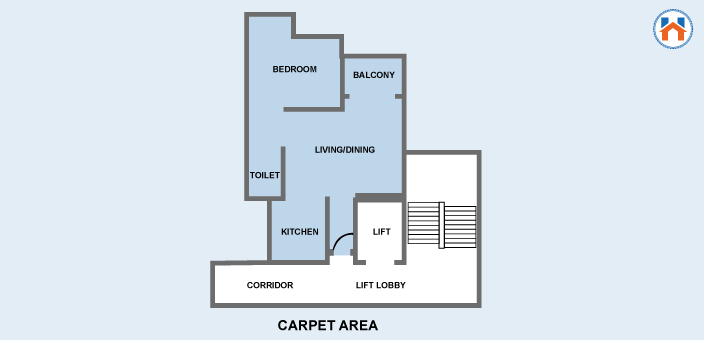
However, RERA’s definition for the Carpet area is slightly different. It takes into account the inner walls in the carpet area.
According to RERA, the carpet area is the total area left after exclusion of the wall thickness of the rooms, exclusive balcony or verandah area, and exclusive open terrace area. But including the thickness of the inner walls.
Remember, builders/developers use Carpet Area defined by the RERA. This means you get the quote by considering the carpet area that includes the inner thickness of the wall.
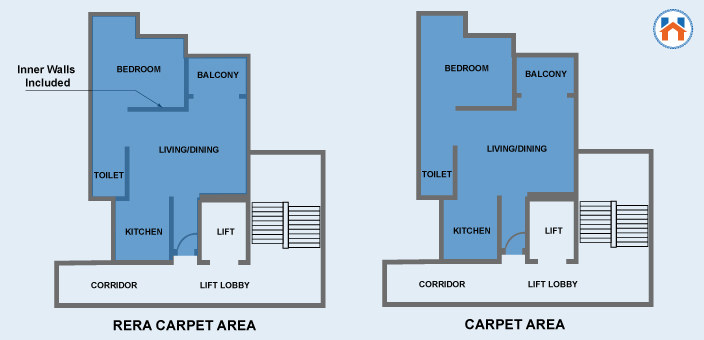
What Carpet Area Covers:
- Rooms- Bedrooms, Dining room, Study Rooms, Dressing Rooms, and Other Rooms
- Bathroom
- Balconies- within Property unit
- A staircase- within the Property unit
- Kitchen
What Carpet Area Does Not Cover:
- External and Internal Walls
- Common areas
- Terrace
- Utility Ducts & Interior Parts
Why Carpet Area is important:
- Buyers get more transparency on the actual usable area.
- Developers/ Builders quote the prices as per the Carpet area defined by RERA. Makes Carpet Area as a standard parameter which helps buyer for comparing the projects.
- Residential housing is defined on the basis of Carpet Area. In Metro Cities 60 sq m and for non-metro cities it is 90 sq m.
- Dealing on the basis of Carpet Area has brought good and efficient design trends in the real estate market.
Important Things Related To Carpet Area:
- Moreover, after the construction, if the carpet area is reduced, the builder is obliged to give the refund of the reduced area within 60 days with annual interest. On the other hand, if the area gets increased in the course of construction the buyer needs to pay for the extra carpet area. In short, the entire recalculation is based on the Carpet Area.
- Cross-check the carpet area and compare it with the actual carpet area for which you are quoted by the builder.
- It is mandatory for the developer to include Carpet Area in marketing collaterals, sales agreements, sales deeds, etc.
- If the Developers/Builders provide misleading information on the Carpet area, a penalty of 5% of the entire real estate project is charged from the developers.
How To Calculate Carpet Area
Carpet Area can be calculated in two ways.
Carpet Area = Total Area of (Bedrooms, Dining Room, Dressing Room, Bathroom, etc) – (Thickness Of the Wall)
Carpet Area From Built up Area:
The carpet area is around 70-85% of the total Built-Up Area.
Carpet Area= (70-85%) of Built up Area.
For example, If the build-up Area is 2000 sq ft, the actual usable carpet area will be as per 70% of the Built-Up Area which is 1400 sq ft.
What Is Built-up Area?
Built-up Area is the total area cover by the apartment.
This includes the entire Carpet Area plus the inner-outer walls and the utility ducts.
The Built up area is always more than the Carpet Area. Usually, it is 15-30% more than the carpet area.
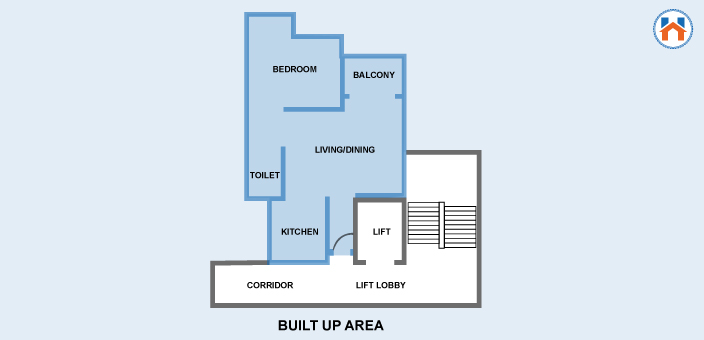
What Built-Up Area Covers:
- Carpet Area
- Inner and External Walls
- Utility Ducts and other interior parts such as water pipelines, sewage pipelines, etc.
What Built-up Area Does Not Cover:
- Lift Lobbies
- Corridors
- Garden Area
- Courtyards
- Tanks
- Conduits etc
How To Calculate Builtup Area:
Builtup Area = Carpet Area + (Inner and Outer Wall Thickness)+ (Utility Ducts and other Interior Parts)
Builtup Area = 15-30% of Carpet Area
Important Points Related to Built-Up Area:
- Before RERA built-up area was the main unit in most real estate deals. There used to be complexity and lack of clarity on how much actual usable area a buyer would get.
- Built up Area has been replaced by more standards and clear unit of Carpet Area.
- Still, the approximate value of the Carpet Area can be estimated by knowing the Built-up area.
What Is Super Built-up Area?
A super Built-up area covers the built-up area of the apartment and common share areas such as lift lobbies, staircase, common entrances, play areas, storage space, parking areas, etc.
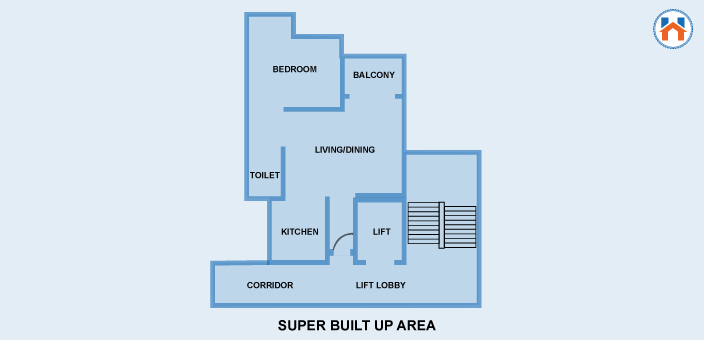
What Built-up Area Covers:
- Built-up area of the property
- Lift Lobbies
- Play Areas
- Common Storage Space
- Common Entrances
- Common basements
- Parking Area
- Terrace
How To Calculate Super-Built-up Area:
Super Built-up Area = Built-up Area + Common Share Area
Super built-up area = Carpet area (1+loading factor)
The loading factor depends on the project location and developer. The average range for loading factor is 15-50%
Important Points Related to Built-up Area:
- The real estate deals on the basis of Super Built-up areas are often confusing and misleading.
- If the developer is sailing the property on the basis of the Built-up area, demand the breakup of the components and specifically the carpet area.
- Currently, the registration at the sub-registrar is based on the Super Built-up Area. But RERA has made it mandatory for the developers in India to market and sell the units on the basis of Carpet Area only.
Why consider Carpet Area over Built-up & Super Built-up Area:
To understand the importance of the carpet area consider the following table showing the comparison between project 1 and project 2.
Both the projects are at the same location and have an equal reputation in the market.
Here the Super Built-up Area is considered a salable area. Meaning, both the developers quote according to the super built-up area.
| Configuration | Super Built-up Area | Total Price | Carpet Area | Rate/Sq ft | |
|---|---|---|---|---|---|
| Project 1 | 1 BHK | 850 sq ft | 72 Lacs | 600 sq ft | 12000 |
| Project 2 | 1 BHK | 850 sq ft | 80 Lacs | 700 sq ft | 11428 |
Conclusions:
- Comparing only on the basis of the Super Built-up area prices is not the right approach.
- As Here, you will notice that even both the project has a same built-up area of 850 sq ft, the usable carpet area for Project 2 Unit is more (700 sq ft).
- Even though Project 2 costs more for the same Super Built-up area, the average cost per sq ft is low than the project 1 unit. This is because the carpet area is more than the project 1 Unit.
- The carpet area is a more transparent and easy parameter to compare and calculate the prices according to the actual usable area.
Comparison: Carpet Area, Built-up Area, and Super Built-up Area
| Carpet Area | Built-up Area | Super Built-up Area | |
|---|---|---|---|
| Definition | The carpet area is the net usable floor area of the apartment. | Built-up Area is the total area cover by the apartment including inner and outer walls. | A super Built-up area covers the built-up area of the apartment and common share areas. |
| Calculation | Carpet Area = Total Area of the rooms - Wall Thickness | Builtup Area= Carpet Area + Inner and Outer Walls | Super Builtup Area= Builtup Area + Common Share Areas |
| Diagram | 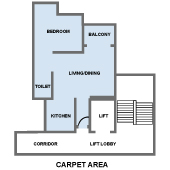 |  | 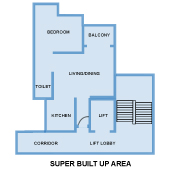 |
| Covers | Rooms- Bedrooms, Dining room, Study Rooms, Dressing Rooms, and Other Rooms Bathroom Balconies- within Property unit A staircase- within the Property unit Kitchen | Carpet Area Inner and External Walls Utility Ducts and other interior parts such as water pipelines, sewage, etc. | Built-up area of the property Lift Lobbies Play Areas Common Storage Space Common Entrances Common basements Parking Area Terrace |








